How To Draw Boxplot In R
Boxplot in R (ix Examples) | Create a Box-and-Whisker Plot in RStudio
In this tutorial, I'll show how to draw boxplots in R.
The tutorial will contain these topics:
- Case ane: Bones Box-and-Whisker Plot in R
- Example 2: Multiple Boxplots in Same Plot
- Case 3: Boxplot with User-Divers Championship & Labels
- Example four: Horizontal Boxplot
- Case 5: Add Notch to Box of Boxplot
- Instance 6: Change Colour of Boxplot
- Case 7: Specify Unlike Colour for Each Boxplot
- Case 8: Add Space Between Boxplots of Dissimilar Groups
- Example nine: Boxplot in ggplot2 Package
- Video & Farther Resources
Here'southward how to do it…
Example i: Bones Box-and-Whisker Plot in R
Boxplots are a popular type of graphic that visualize the minimum non-outlier, the showtime quartile, the median, the tertiary quartile, and the maximum not-outlier of numeric information in a single plot.
Let'southward create some numeric example data in R and see how this looks in practise:
ready . seed ( 8642 ) # Create random data x <- rnorm( 1000 )
set.seed(8642) # Create random data x <- rnorm(k)
Our example information is a random numeric vector post-obit the normal distribution. The information is stored in the data object x.
We can now plot these information with the boxplot() function of the base installation of R:
boxplot(x) # Basic boxplot in R
boxplot(x) # Bones boxplot in R
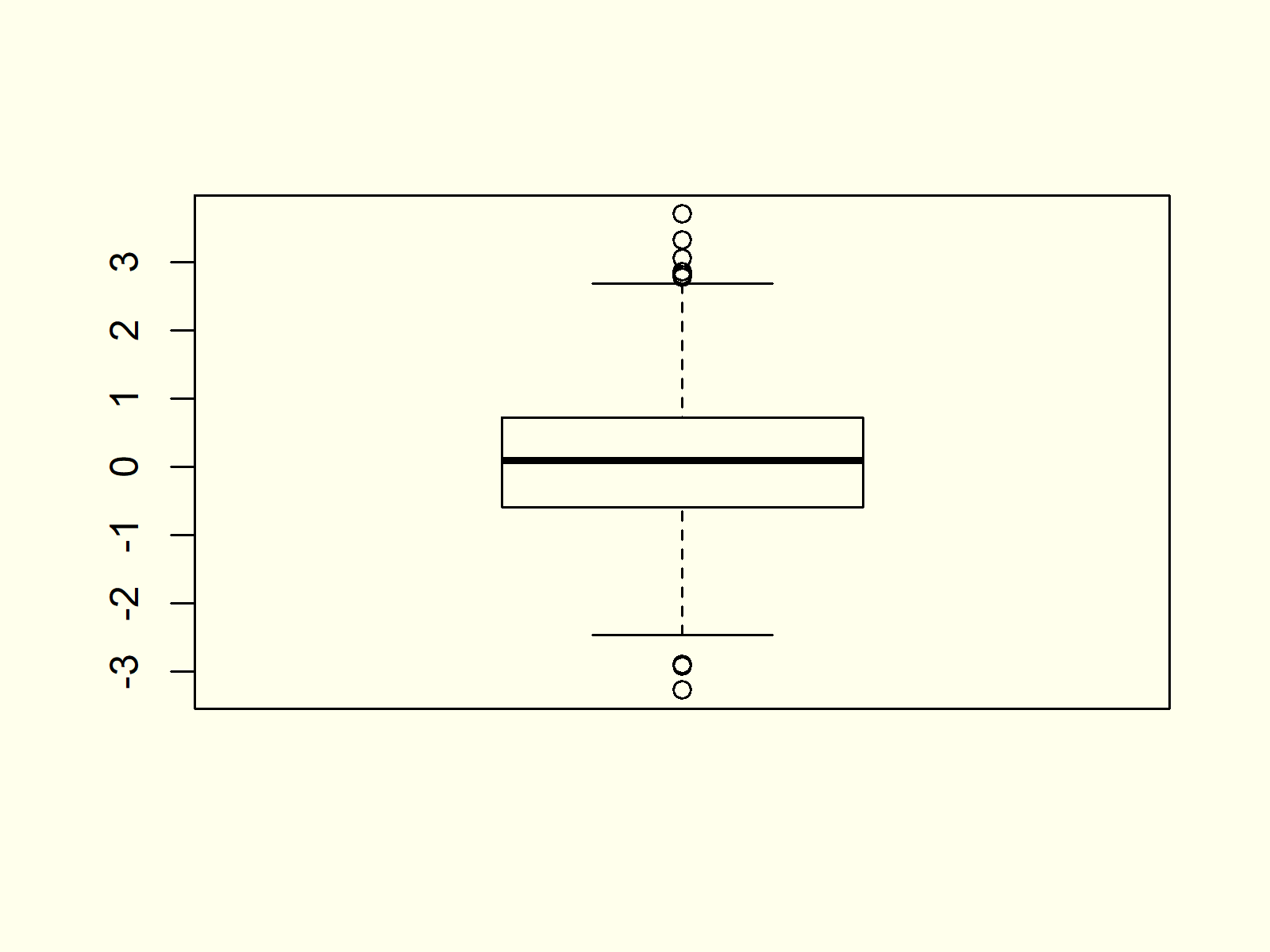
Figure one: Basic Boxplot in R.
Effigy one visualizes the output of the boxplot command: A box-and-whisker plot. Every bit you tin meet, this boxplot is relatively uncomplicated. In the post-obit examples I'll show you lot how to modify the dissimilar parameters of such boxplots in the R programming language.
Case 2: Multiple Boxplots in Same Plot
In Instance 2 you'll learn how to draw a graph containing multiple boxplots side by side in R. First, we need to create some more than data that we can plot in our graphic.
The following R lawmaking creates a uniformly distributed variable y and a poisson distributed variable z:
y <- runif( grand ) # Create more variables z <- rpois( thou, 3 )
y <- runif(chiliad) # Create more variables z <- rpois(1000, 3)
Now, we can shop our three variables 10, y, and z in a data frame:
data <- information. frame (values = c(10, y, z), # Combine variables in data frame grouping = c(rep( "x", 1000 ), rep( "y", m ), rep( "z", m ) ) ) head(information) # First 6 rows of data # values grouping # -0.8035458 ten # 0.6384819 x # -0.1417869 x # two.1542073 x # -0.1220888 10 # -0.7332229 ten
data <- data.frame(values = c(x, y, z), # Combine variables in data frame group = c(rep("x", 1000), rep("y", 1000), rep("z", 1000))) head(data) # Get-go half-dozen rows of information # values group # -0.8035458 x # 0.6384819 x # -0.1417869 x # 2.1542073 10 # -0.1220888 x # -0.7332229 x
If we want to create a graphic with multiple boxplots, we have to specify a cavalcade containing our numeric values, the grouping column, and the data frame containing our information:
boxplot(values ~ grouping, information) # Multiple boxplots in same graph
boxplot(values ~ grouping, data) # Multiple boxplots in same graph
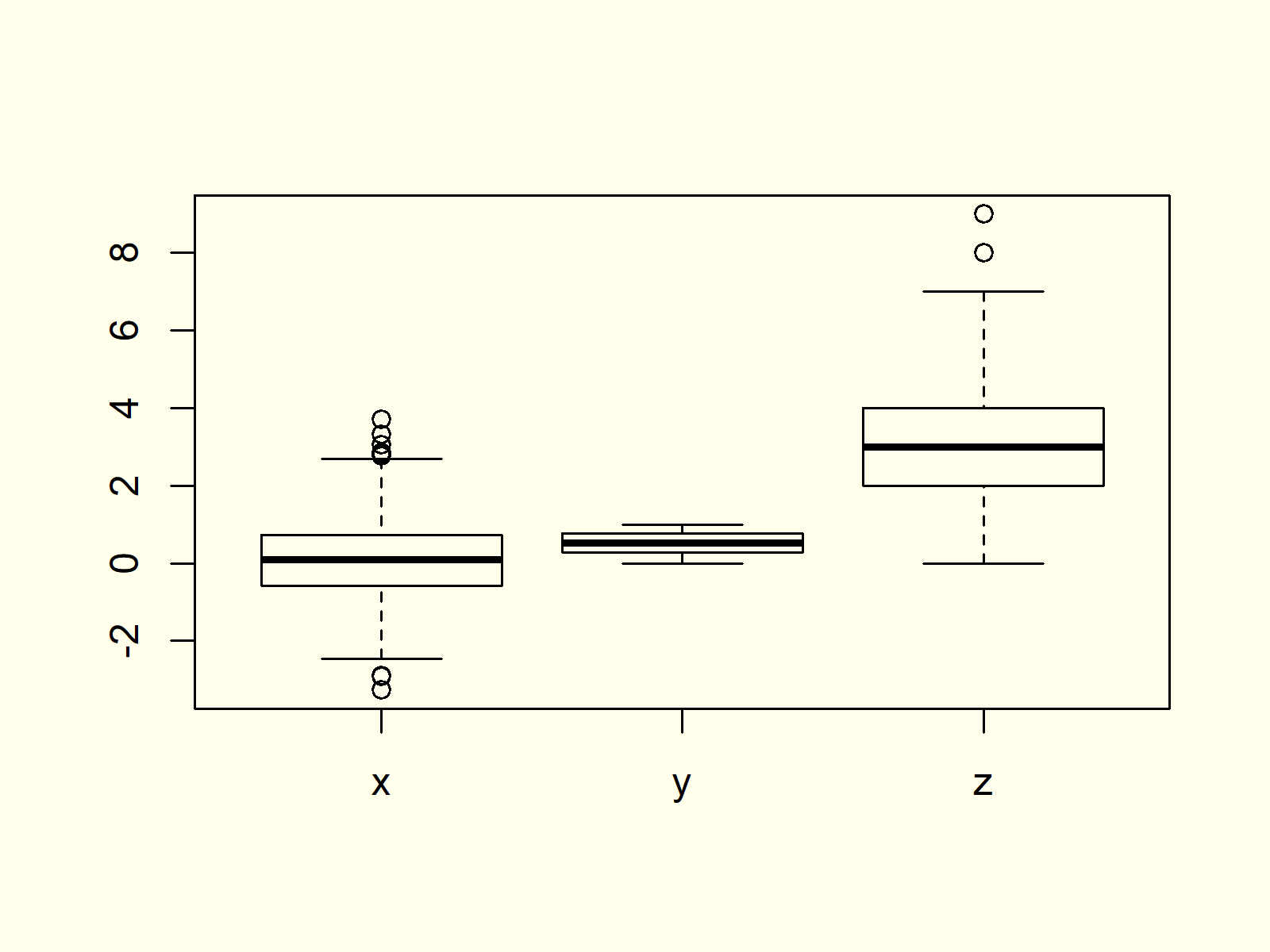
Figure two: Multiple Boxplots in Same Graphic.
As you lot can see based on Figure 2, the previous R lawmaking created a graph with multiple boxplots.
Example 3: Boxplot with User-Defined Title & Labels
The boxplot function also allows user-defined main titles and axis labels. If we want to add such text to our boxplot, nosotros demand to employ the master, xlab, and ylab arguments:
boxplot(values ~ group, data, # Change master title and axis labels chief = "My Boxplots", xlab = "My Boxplot Groups", ylab = "The Values of My Boxplots" )
boxplot(values ~ grouping, data, # Change principal title and axis labels main = "My Boxplots", xlab = "My Boxplot Groups", ylab = "The Values of My Boxplots")
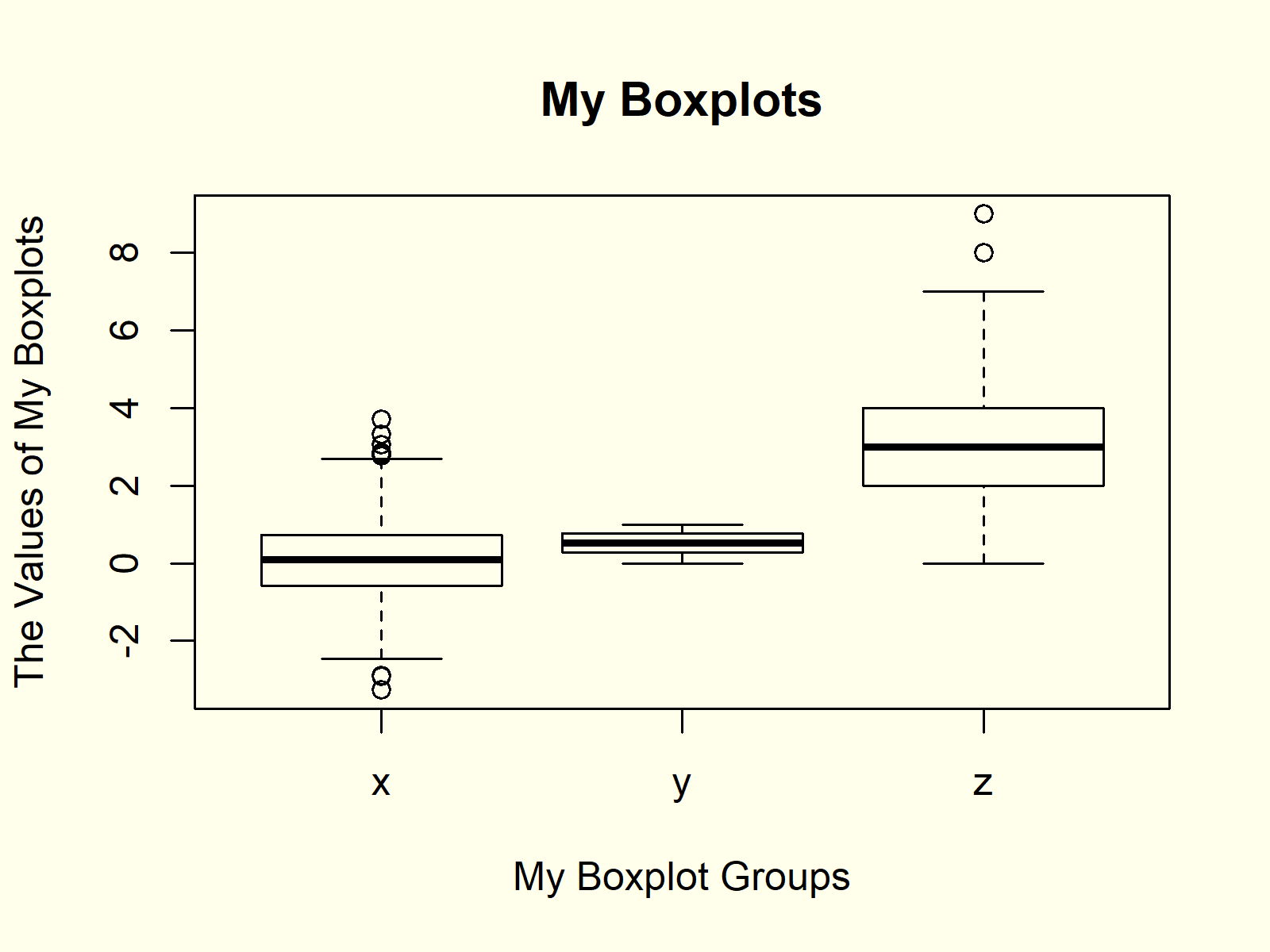
Figure three: Inverse Primary Title & Centrality Labels.
Example four: Horizontal Boxplot
We tin can align our boxplots horizontally with the argument horizontal = Truthful:
boxplot(values ~ group, data, # Horizontal boxplots horizontal = True )
boxplot(values ~ group, data, # Horizontal boxplots horizontal = TRUE)
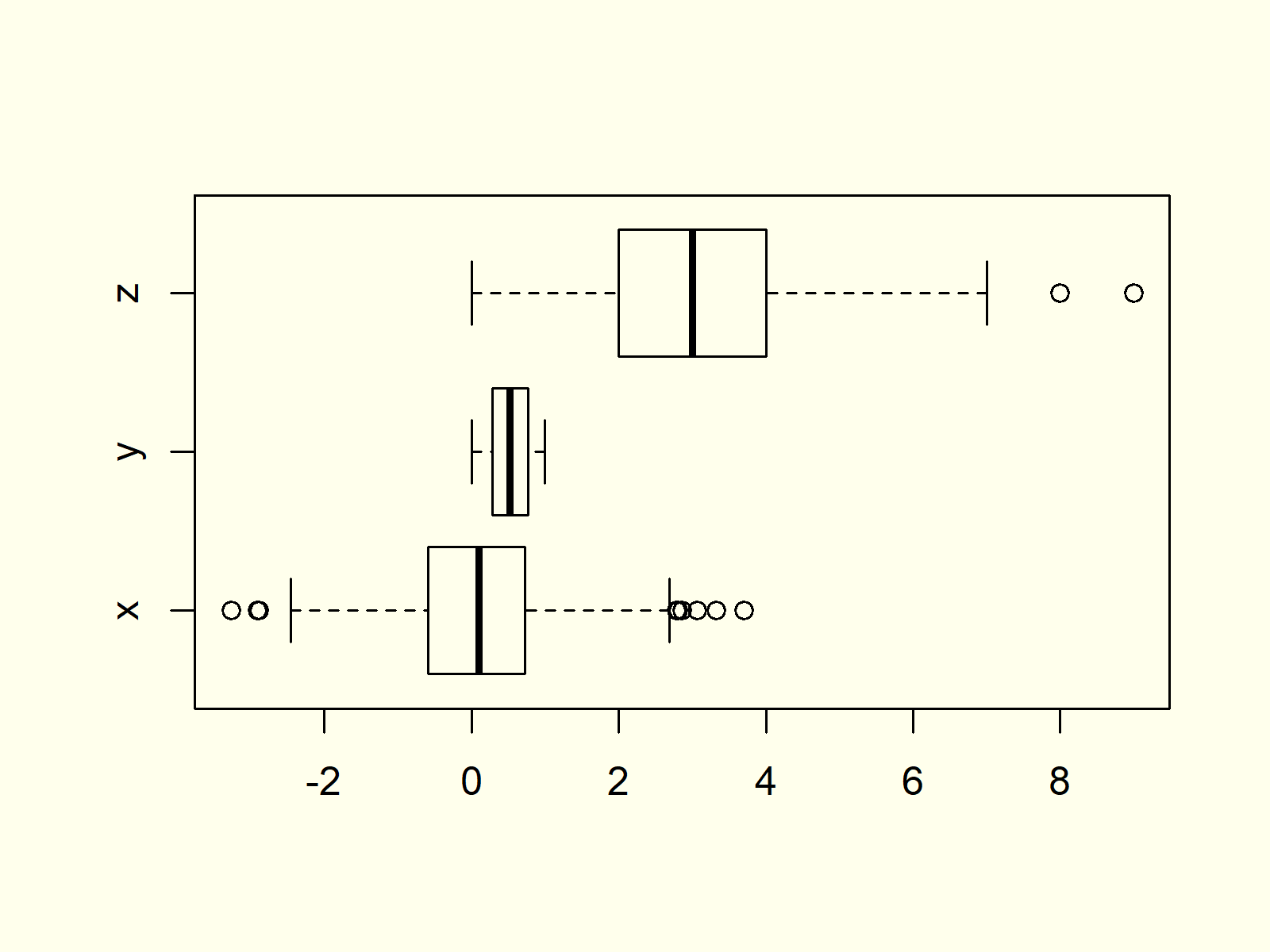
Figure iv: Horizontally Aligned Boxplots.
Every bit y'all can run across based on Figure 4, the previous R syntax changed the Ten- and Y-Axes of our plot.
Instance five: Add Notch to Box of Boxplot
If nosotros desire to make the middle of our boxplots thinner, we can use the notch argument:
boxplot(values ~ group, data, # Thin boxplots notch = True )
boxplot(values ~ group, information, # Thin boxplots notch = TRUE)
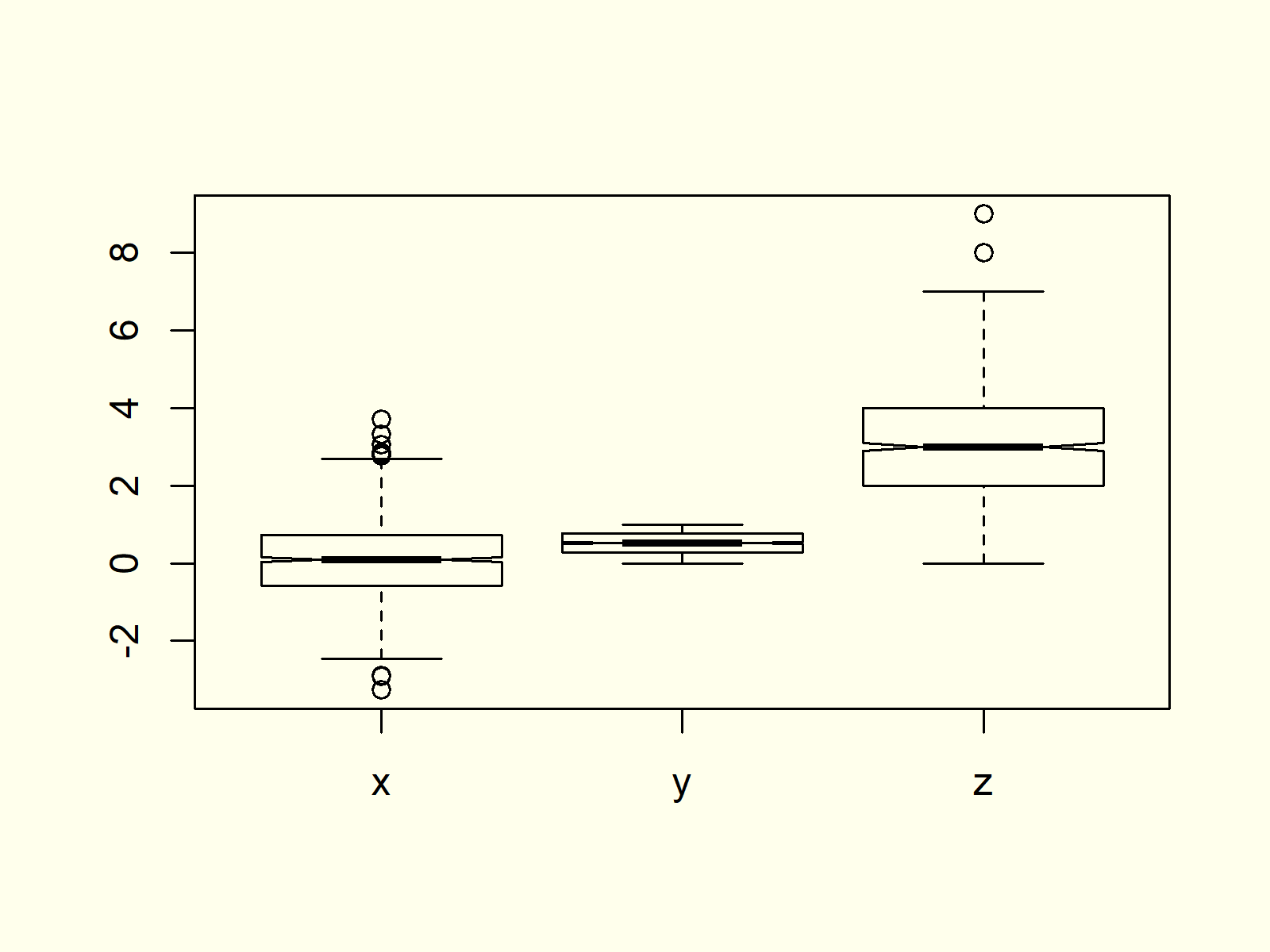
Effigy v: Thinner Boxplots.
Instance 6: Change Color of Boxplot
Some other popular modification of boxplots is the filling colour. If we desire to change all our boxplots to the same color, we can specify the col statement to be equal to a unmarried color:
boxplot(values ~ group, data, # Colour of boxplots col = "red" )
boxplot(values ~ group, data, # Color of boxplots col = "ruby")
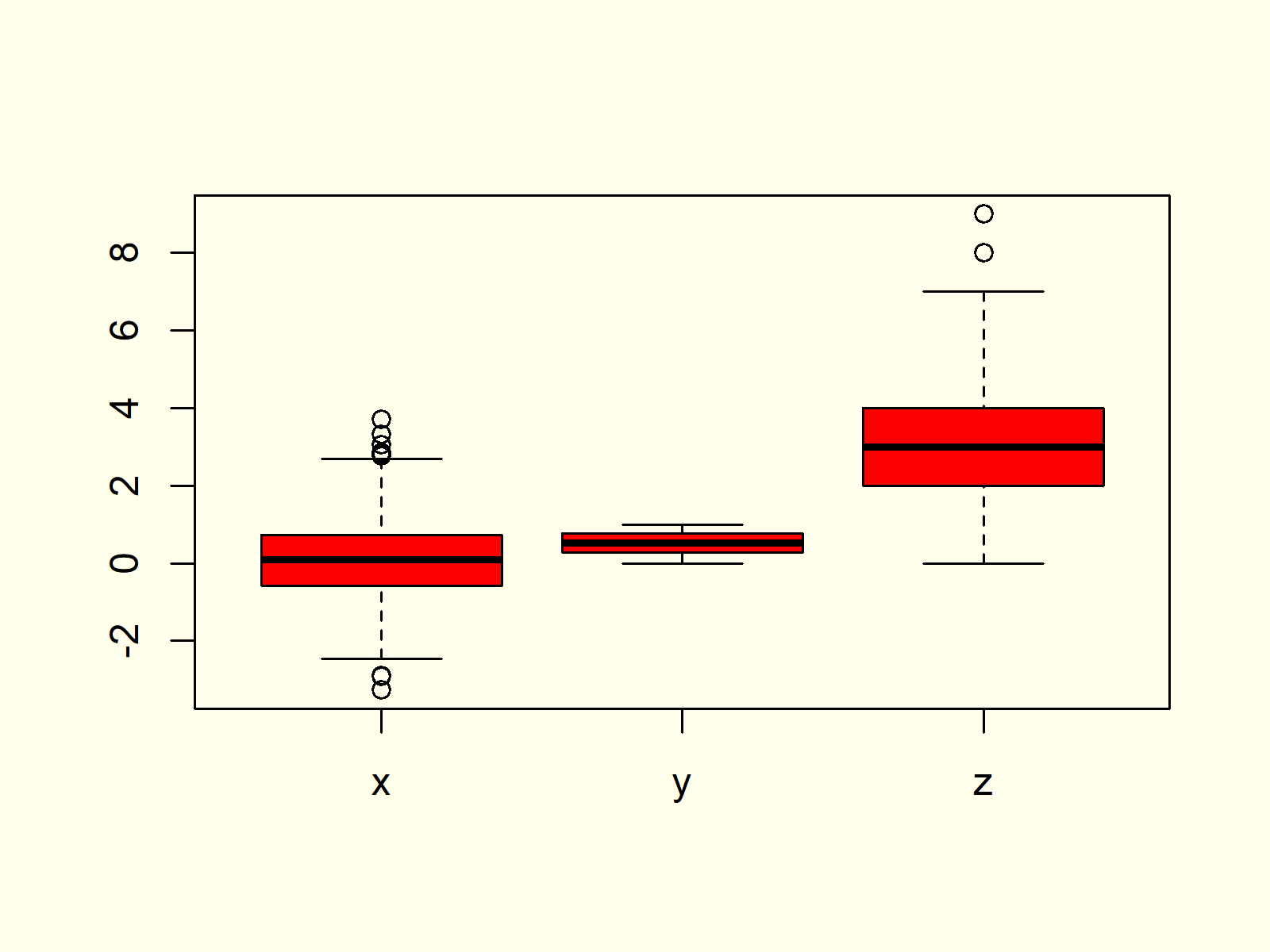
Figure half dozen: Change Color of All Boxplots.
Instance 7: Specify Different Color for Each Boxplot
If we want to impress each of our boxplots in a different color, we have to specify a vector of colors containing a colour for each of our boxplots:
boxplot(values ~ group, information, # Different colour for each boxplot col = c( "reddish", "greenish", "majestic" ) )
boxplot(values ~ group, data, # Different colour for each boxplot col = c("reddish", "greenish", "purple"))
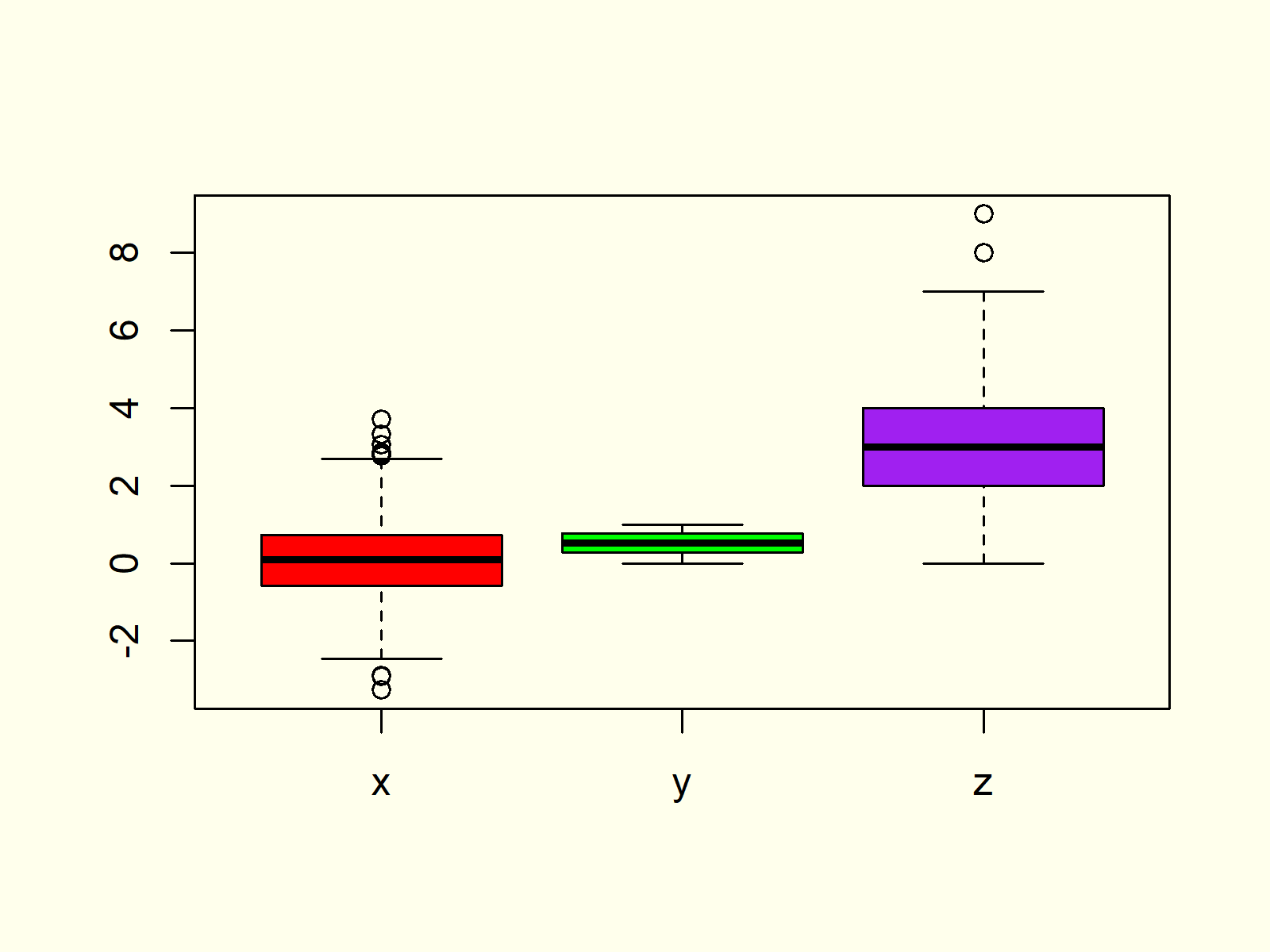
Figure 7: Specify Dissever Colour for Each Boxplot.
Example eight: Add Space Between Boxplots of Different Groups
Often, we want to cluster our boxplots into different groups (e.grand. male and female). In such a example it makes sense to add some additional spacing to our boxplot.
Allow'south commencement modify our data then that each boxplot is divided into subgroups:
data2 <- data # Replicate data data2$group <- c(rep( "x1", 500 ), rep( "x2", 500 ), # Modify grouping variable rep( "y1", 500 ), rep( "y2", 500 ), rep( "z1", 500 ), rep( "z2", 500 ) )
data2 <- information # Replicate data data2$group <- c(rep("x1", 500), rep("x2", 500), # Modify group variable rep("y1", 500), rep("y2", 500), rep("z1", 500), rep("z2", 500))
At present, we tin use the at option of the boxplot office to specify the exact positioning of each boxplot. Annotation that we are leaving out the positions 3, 4, 7, and eight:
boxplot(values ~ group, data2, # Boxplot with manual positions col = c( "bluish", "pinkish" ), at = c( i, two, v, six, 9, 10 ) )
boxplot(values ~ group, data2, # Boxplot with manual positions col = c("blue", "pink"), at = c(i, 2, v, 6, 9, 10))
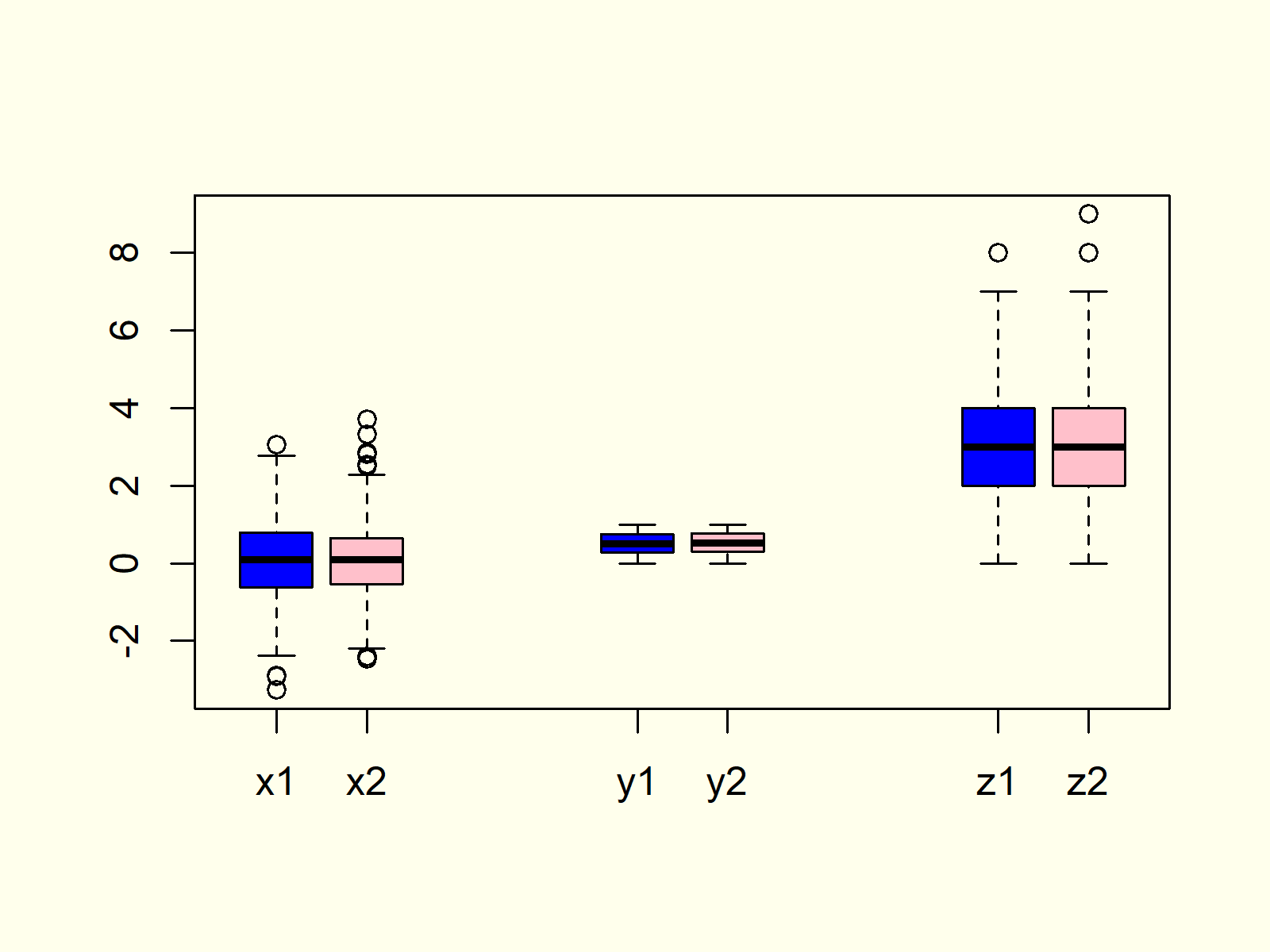
Effigy 8: Change Spacing/Positioning of Boxplots.
Example 9: Boxplot in ggplot2 Package
Then far, nosotros have created all the graphs and images with the boxplot function of Base of operations R. However, at that place are also many packages that provide pretty designs and additional modification possibilities for boxplots.
In the case, I'll show you how to create a boxplot with the ggplot2 parcel. Let's install and load the package to RStudio:
install. packages ( "ggplot2" ) # Install and load ggplot2 library( "ggplot2" )
install.packages("ggplot2") # Install and load ggplot2 library("ggplot2")
Now, we can utilize the ggplot and geom_boxplot functions of the ggplot2 package to create a boxplot:
ggplot(data2, aes(x = group, y = values, fill = group ) ) + # Create boxplot chart in ggplot2 geom_boxplot( )
ggplot(data2, aes(x = grouping, y = values, fill up = grouping)) + # Create boxplot nautical chart in ggplot2 geom_boxplot()
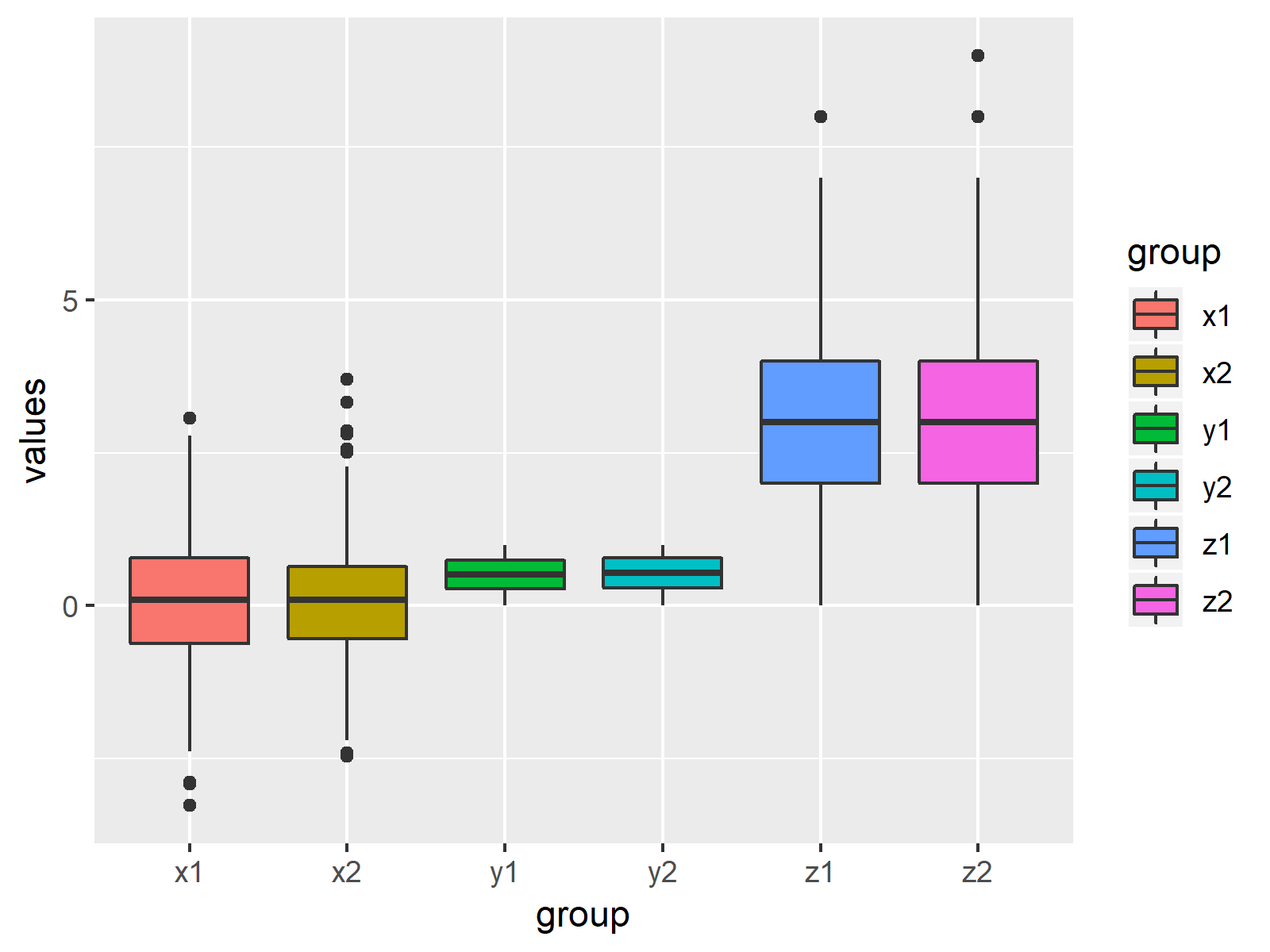
Figure ix: Boxplots Created past ggplot2 Package.
There are many other packages providing different designs and styles. Withal, the ggplot2 package is the virtually pop packet amid them.
Video & Further Resource
Exercise yous need further information on the R programming code of this commodity? Then you might want to watch the following video of my YouTube channel. In the video, I'm explaining the R syntax of this article:
Furthermore, yous might have a look at the other tutorials of this website. I have released numerous tutorials already:
- Jitter Boxplots in R
- R Graphics Gallery
- R Functions List (+ Examples)
- The R Programming Language
Summary: You learned in this tutorial how to make a boxplot in RStudio. Don't hesitate to allow me know in the comments below, in example you have boosted questions.
Source: https://statisticsglobe.com/boxplot-in-r
Posted by: fostersagoonger.blogspot.com


0 Response to "How To Draw Boxplot In R"
Post a Comment